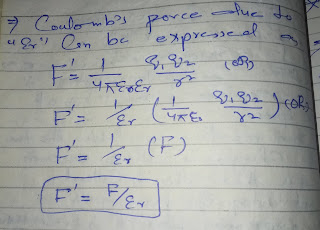Electrostatic :
The Branch Of Electromagnetism Which Deals With Study Charges at Rest is Called Electrostatics.
Charge :
The Property Of Matter That is Responsible For Electrical Phenomenon Existening in The Positive and Negative Form is Called Charge.
. There are Two Types Of Charges i.e Positive and Negative.
. Like Charges Always Repeall Each Other and Un-like Charges Always Attract Each other.
. Charge is a Conserved Quantity in an Isolated System.
. Charge Can Be Created or Destroyed in Equal and Opposite Pair. When a " Gamma" Radiation Of Energy 1.02 Mev Pass Through a Heavy Nucleus, it Produces a Pair Of Elcetron and Positron this process is known as Pair Production
. When a Pair Of Electron and Positron is Combine Together Then it Gets Converted, This Process Is Known as Annihilation Of Pair, Now it is elear That in Equal and Opposite Pair Charge Can Be Created as Well as Destroyed.
. Charge is Measured By Electrometer,
. Charge is Delected By Gold Leaf Electroscope (GLE)
. By Nature Charge is a Scalar Quantity.
. S. I Unit Of Charge is "Coulomb(cb) "
. C. G. S Unit Of Charge is "Fron Klin "
. F. P. S Unit Of Charge is F. S. U
1 e. s. U = 1/3x10^9c
. Charge is a Quantized Quantity Because it is Multiple Of "n" Number of e^- or p^+ With The Smallest Magnitude Of Charge .
. The Smallest Magnitude Of Charge is Denoted By "e" and is Equal To 1.602x10^-19C
. The Formula Quantized Charge is " Q = ne "
. When One Coulomb Charge Passes Through a Conductor Then it Passes 6.25x10^18e
. Charge is Associated With Mass i. e Charge Can n't Exist Without Mass
. Charge is Transforable Quantity.
. Charge Transference Of Charge Involves Mass.
. The Transference Of Charge From One Place To another Place is Known as Charging
. There are Three Types Of Charging.
i). Charging By Conduction.
ii). Charging By induction.
iii). Charging By Fraction.
iv). Charging By Contact.
Coulomb's Law :
This Law was Put Forward By The Scientist Charles Augustine Coulomb in 1784.
This Law States That The Force Of Attraction or Repealtion Between The Two Point Charges is Directly Proportional To Magnitude Of Product Of Charges and inversely Proportional to Square Of The Distance Between them.
Mathematically :
. Where as "K" is The Constant Of Proportionality and is Also Known As Coulomb's Constant.
. This Value Depends On Two Factor i. e (i) Medium Used Between The point Charges.
(ii). System Of Unit Chosen
. The Expression For "K" is K = 1/4πr = 9x10^9 Nm^2/c^2 ( Epsilon nought) is Known as The Permitivity Of Free Space.
. When Medium Used Between The Two Point Charges is Either Vaccum or Air Then this is Called Permitivity Of Free Space.
. The Expression For "eo" is eo = 8.843x10^-12c^2/Nm^2
. The unit of "eo" is also " farad / meter" Which is Equal To C^2/Nm^2.
. When The Medium Between Two Charges is Vaccum or air Then Coulomb's Law Can Be Expressed as F = 1/4πr q1q2/r^2.
. When The Medium Used Between The Two Point Charges is Other Than air Vaccum Then This is Called Relative Permitivity (Er) it is also Called Dielectric i. e The Media like Water, Mica, Wood ,Cotton, Transformer oil, Parafined paper etc are The Dielectric
. Coulomb 's Force Due To Er Can be Expressed as.
. Problem On Above Equation
. The Electrostatic Force Between The Two Point Charges is 2N When Vaccum Exist Between Them What Will Be Coulomb's Force if Water is Placed Between Point Charge For Water Er=80
Sol .'. F^' = F/er
= 2/80
= 1/40 =0.025
. From the above Problem it is Clear That Coulomb's Force Gets Reduced When The Dielectric Medium i. e Other Than air or Vaccum is Placed Between Two Point Charges.
. Coulomb's Law Resembles With Law Of Universal Gravitation.
. In the Mechanics The Gravitational Force Provides Centripetal Force as in The Atomic Physics The Centripetal Force is Provided To an Electron By Coulomb's Force
. The Coulomb's Force is 10^39 Time Greater Than Gravitational Force.
Fe/FG = k. q1. q2 /r^2 /G. m1. m2 / r^2
Fe / FG = k. q1. q2 / G.m1.m2
Fe / GG = 9x10^9 x 1.602x10^-19 x 1.602x10^-19 / 6.67x10^-11 x 1.67x10^-27 x 9.1x10^-31
= 2. X 10^39 may be
Point Charge :
The charge Of Negligible Size is Called Point Charge.
. It Exists With The Smallest Magnitude e = 1.602x10^-19C .
. It is Denoted By " +q" For Positive and "q" For Negative.




0 Comments